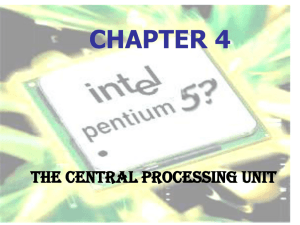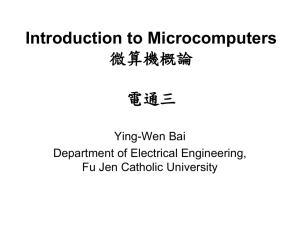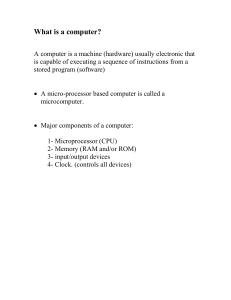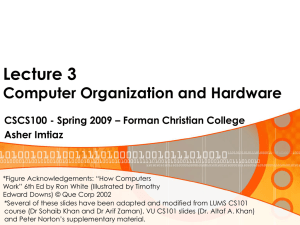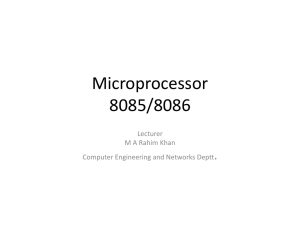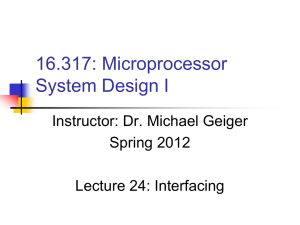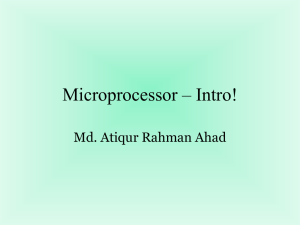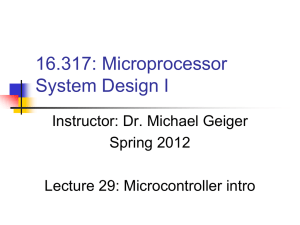File - onlyprogrammerz
advertisement
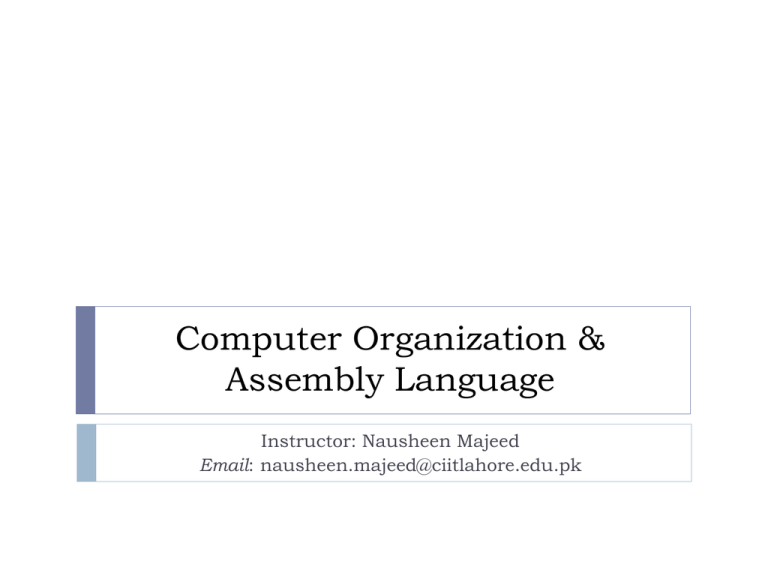
Computer Organization & Assembly Language Instructor: Nausheen Majeed Email: nausheen.majeed@ciitlahore.edu.pk Course Objective To understand organization of a computer system To gain an insight knowledge about the internal architecture and working of microprocessors. To understand working of memory devices, interrupt controllers and I/O devices. To learn Assembly Language 2 Course Contents Introduction to Microprocessors History & Evolution of Intel Microprocessors Organization of Intel 8086 Processor Fetch-Execution Cycle Microprocessor Bus Structure Internal Memory, External Memory, Input Output Devices Instruction Representation Memory Organization & Structure Memory Addressing Cache Interrupts, DMA Pipelining 3 Contd.. Introduction of Assembly Language: Data Declaration Loop and Jump Using Arithmetic and Logical Instructions Using Shift and rotate instructions Input / Output and display text Stack and operations on stack Subroutine and Procedures Interfacing with High level languages Overview of Debugger and practice of writing and debugging programs Using EMU8086 to write and test assembly language programs Introduction to Microcontroller Programming 4 Text Books Assembly Language programming and Organization of the IBM PC by Ytha Yu and Charles Marut. Computer Organization and Architecture, William Stallings Kip Irvine, “Assembly Language for Intel-Based Computers”, Third Edition,, Prentice Hall Incorporated 5 Outline Introduction to Computer Organization An Introduction to Microprocessors History of Intel 8086 Microprocessors An Introduction to Assembly Language 6 Introduction 7 What is Computer Organization? Organization is how features are implemented. How does a Computer Work? For Example: Is there a special hardware multiply unit for multiplication operation or is it done by repeated addition? 8 Structure & Function Structure is the way in which components relate to each other Function is the operation of individual components as part of the structure. Main functions performed by a computer system are: Data processing Data storage Data movement Control 9 Contd.. When data is received from or delivered by a device that is directly connected to the computer, process is called Input-Output (I/O). When data are moved over longer distance, to or from a remote device, the process is known as Data Communication. 10 Structure - Top Level Peripherals Computer Central Processing Unit Computer Main Memory Systems Interconnection Input Output Communication lines 11 Structure - The CPU CPU Computer Arithmetic and Login Unit Registers I/O System Bus Memory CPU Internal CPU Interconnection Control Unit 12 Structure - The Control Unit Control Unit CPU Sequencing Logic ALU Internal Bus Registers Control Unit Control Unit Registers and Decoders Control Memory 13 Microprocessors 14 Microprocessor Microprocessor is an electronic circuit that functions as the central processing unit (CPU) of a computer, providing computational control. Microprocessors are also used in other advanced electronic systems, such as computer printers, automobiles, and jet airliners. 15 Processor Integration Early computers had many separate chips for the different portions of a computer system Registers Control 16 ALU Memory Microprocessors Data Bus Address Bus CPU (ALU + Reg + control) Memory I/O Devices Control Bus First microprocessors placed control, registers, arithmetic logic unit in one integrated circuit (one chip). 17 Modern Processors Modern microprocessors (general purpose Processors) also integrate memory onchip for faster access. External memory and I/O components still required. Memory integrated on the microprocessor is called cache memory. Data Bus CPU Registers, ALU, Fetch, Exe Logic, Bus logic, Cache Memory Address Bus Memory Control Bus 18 I/O Devices Microcontrollers Microcontrollers integrate all of the components (control, memory, I/O) of a computer system into one integrated circuit. Microcontrollers are intended to be single chip solutions for systems requiring low to moderate processing power. Microcontroller 19 Microprocessor vs. Microcontroller Microprocessor CPU is stand-alone, RAM, ROM, I/O, timer are separate designer can decide on the amount of ROM, RAM and I/O ports. general-purpose 20 Microcontroller CPU, RAM, ROM, I/O and timer are all on a single chip fix amount of on-chip ROM, RAM, I/O ports single-purpose History of Intel Microprocessors 1971 - 4004 Followed in 1972 by 8008 First microprocessor All CPU components on a single chip 4 bit 8 bit Both designed for specific applications 1974 - 8080 21 Intel’s first general purpose microprocessor Pentium Evolution (1) 8080 8086 much more powerful 16 bit instruction cache, prefetch few instructions 8088 (8 bit external bus) used in first IBM PC 80286 first general purpose microprocessor 8 bit data path Used in first personal computer – Altair 16 Mbyte memory addressable up from 1Mb 80386 22 32 bit Support for multitasking Pentium Evolution (2) 80486 Pentium sophisticated powerful cache and instruction pipelining built in maths co-processor Superscalar Multiple instructions executed in parallel Pentium Pro 23 Increased superscalar organization Aggressive register renaming branch prediction data flow analysis speculative execution Pentium Evolution (3) Pentium II Pentium III Additional floating point instructions for 3D graphics Pentium 4 MMX technology graphics, video & audio processing Note Arabic rather than Roman numerals Further floating point and multimedia enhancements Itanium 24 64 bit Assembly Language 25 Programming Languages High-Level Languages (HLL) Assembly Language Machine Language 26 High-Level Language Allow programmers to write programs that look more like natural language. Examples: C++, Java, C#.NET etc A program called Compiler is needed to translate a high-level language program into machine code. Each statement usually translates into multiple machine language instructions. 27 Machine Language The "native" language of the computer Numeric instructions and operands that can be stored in memory and are directly executed by computer system. Each ML instruction contains an op code (operation code) and zero or more operands. Examples: Opcode Operand Meaning ------------------------------------------------40 increment the AX register 05 0005 add 0005 to AX 28 Assembly Language Use instruction mnemonics that have one-to-one correspondence with machine language. An instruction is a symbolic representation of a single machine instruction Consists of: label always optional mnemonic always required operand(s) required by some instructions comment always optional 29 Sample Program Written in Debug 1. mov ax, 5 2. add ax, 10 ax ax 05 Me m or y 011C 011E 15 35 3. add ax, 20 4. mov [0120], ax 5. int 20 30 ax ax 35 0120 0122 35 0124 0126 Figure 1. Machine Language Generation by ASM and HLL programs. ASM ML ML H LL ML ML ML 31 Why Learn Assembly Language? Learn how a processor works Explore the internal representation of data and instructions Allows creation of small and efficient programs Provides a convenient way to directly access the computers hardware Programmers write subroutine also known as Interface Subroutine / device drivers in assembly language and call them from high-level language programs. 32 Essential Tools Assembler is a program that converts source-code programs into a machine language (object file). Linker joins together two or more object files and produces a single executable file. Debugger loads an executable program, displays the source code, and lets the programmer step through the program one instruction at a time, and display and modify memory. Emulator allows you to load and run assembly language programs, examine and change contents of registers. Example: EMU8086 33 References Chapter 1 & 3, Ytha Yu and Charles Marut, “Assembly Language Programming and Organization of IBM PC”, Chapter 3,William Stallings,“Computer Organization & Architecture” Chapter 1, Kip Irvine, “Assembly Language for Intel-Based Computers”, Third Edition,, Prentice Hall Incorporated 34

